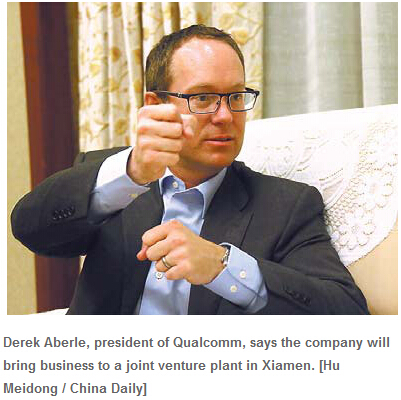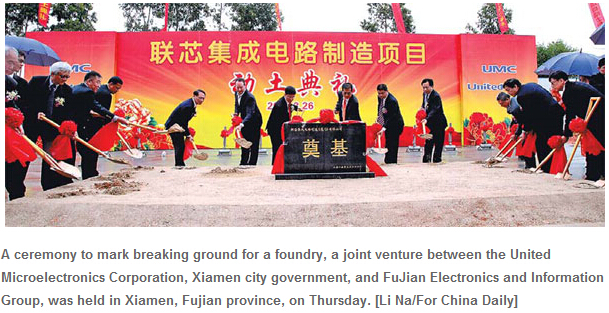Qualcomm, a world leader in wireless technologies and wireless chipsets, will continue to build its cooperation with the semiconductor industry in China and build up the semiconductor ecosystem in China.
As the world's leading semiconductor company with outsourced fabrication, Qualcomm Inc has been engaged in the semiconductor industry in China for several years. On Thursday, the President of Qualcomm, Derek Aberle, was one of the dignitaries in attendance at a ceremony to mark breaking ground for a 12-inch wafer plant in Xiamen, Fujian province.
The joint venture between the United Microelectronics Corporation, Xiamen city government, and Fujian Electronics and Information Group will focus on 40 nanometer and 50nm technologies. Aberle said Qualcomm will help get the plant up and running as soon as possible.
"The fabrication will begin with the 40nm and 50nm parts, which aligns well with what we see as the biggest drivers of growth in the semiconductor industry over the next five to 10 years: non-handset connected devices and the opportunities arising from the Internet of Things," Aberle said. Qualcomm has already established a successful fab collaboration in China with Semiconductor Manufacturing International Corporation. Qualcomm has been the largest customer of SMIC for some time, and it pushed the collaboration in order to support SMIC on the fabrication of 28nm process technology. Produced in Shanghai last year, it was the first 28nm developed in China, Aberle said.
"The fabricators need the process technology, but they also need to have a lead customer that has the experience, the know-how and the skill to actually mature the technology, and get the yields up so they can have a profitable business," Aberle said.
The company aims to focus on leading node technology, Aberle said. "The 28nm is leading node. While for the Internet of Things sector, the 40nm in Xiamen is leading node for that particular application," Aberle said. Although the way Qualcomm expects to be engaged in China is very similar with what the company has done with other fabricators in other places in the world, Aberle does see definite benefits to being in China. "The market is so large, and there is a lot of consumption and manufacturing within China," Aberle said, adding, "Qualcomm will bring business into the plant in Xiamen."
Qualcomm is a major client of UMC and the new plant in Fujian province is the latest fruit of their long-established partnership.
Xiamen serves as an ideal location for UMC as the city has very strong infrastructure, and there is a lot of good support from the local and the provincial government for this particular project, Aberle said.
He added another benefit of choosing Xiamen is its proximity to Taiwan, which means UMC would be able to manage operations effectively and efficiently.
"The proximity is a benefit for the integrated circuit industry generally. It's good for IC companies to have manufacturing capacity available to them," Aberle said.
"We're basically helping the fabs develop their process and the technology. Once its done, its not just for Qualcomm, they will have process in the fab here that could serve any semiconductor company, including local ones.. That will be one of the key engines of growth for other semiconductor companies in the area that need capacity. So it's both making our own chips here and technology contribution to help them get their technology into the market," Aberle said.
The company is considering moving some other pieces of the supply chain to China, such as testing facilities.


